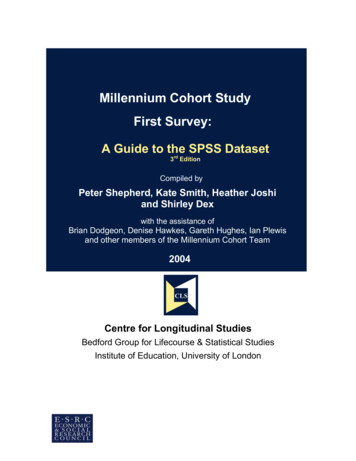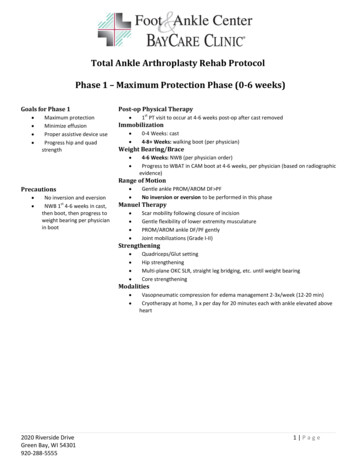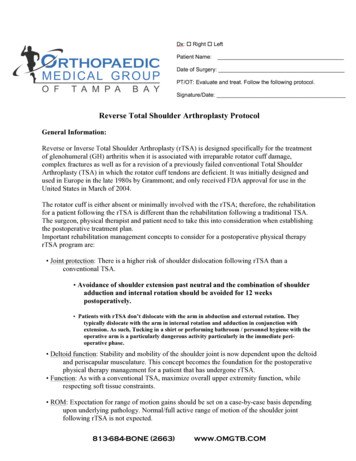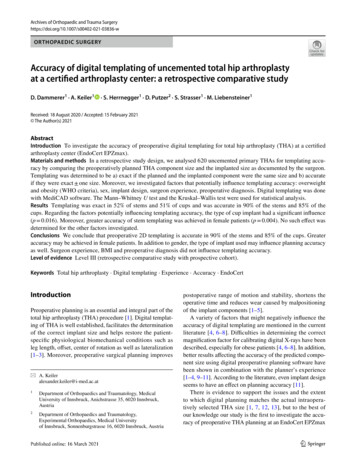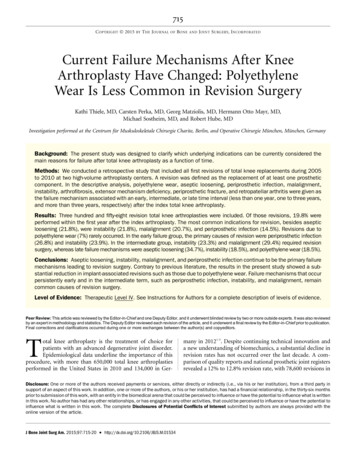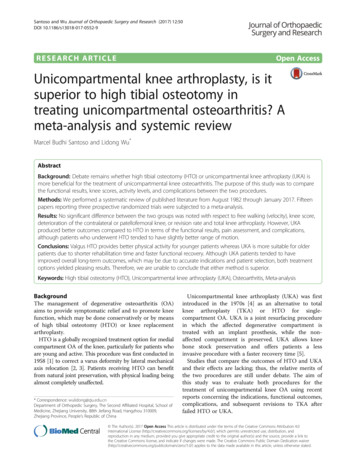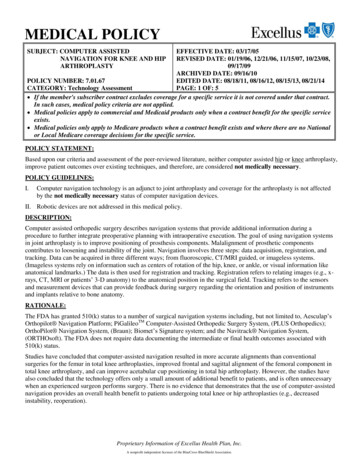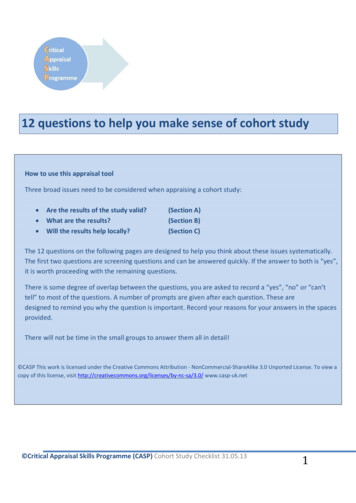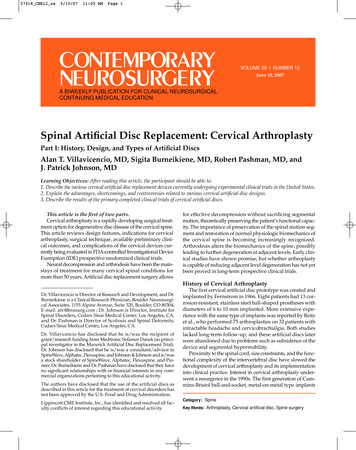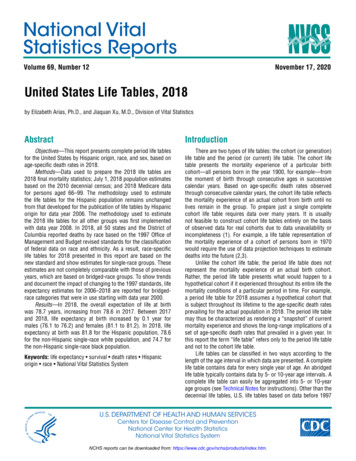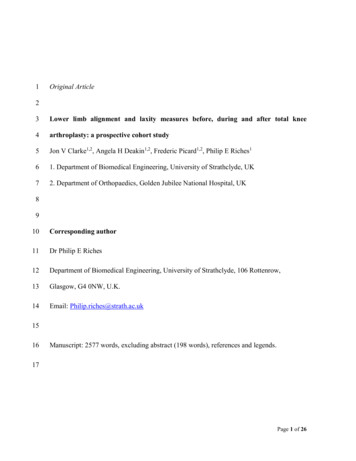
Transcription
1Original Article23Lower limb alignment and laxity measures before, during and after total knee4arthroplasty: a prospective cohort study5Jon V Clarke1,2, Angela H Deakin1,2, Frederic Picard1,2, Philip E Riches161. Department of Biomedical Engineering, University of Strathclyde, UK72. Department of Orthopaedics, Golden Jubilee National Hospital, UK8910Corresponding author11Dr Philip E Riches12Department of Biomedical Engineering, University of Strathclyde, 106 Rottenrow,13Glasgow, G4 0NW, U.K.14Email: Philip.riches@strath.ac.uk1516Manuscript: 2577 words, excluding abstract (198 words), references and legends.17Page 1 of 26
18Abstract19Background. This study compared knee alignment and laxity in patients before, during and20after total knee arthroplasty, using methodologically similar procedures, with an aim to help21inform pre-operative planning.22Methods. Eighteen male and 13 female patients were recruited, mean age 66 years (51-82)23and mean body mass index of 33 (23-43). All were assessed pre- and postoperatively using24a non-invasive infrared position capture system and all underwent total knee arthroplasty25using a navigation system. Knee kinematic data were collected and comparisons made26between preoperative clinical and intraoperative measurements for osteoarthritic knees, and27between postoperative clinical and intraoperative measurements for prosthetic knees.28Findings. There was no difference in unstressed coronal mechanical femoral-tibial angles29for either osteoarthritic or prosthetic knees. However, for sagittal alignment the knees were30in greater extension intraoperatively (osteoarthritic 5.2 p 0.001, prosthetic 7.2 p 0.001).31For osteoarthritic knees, both varus and valgus stress manoeuvres had greater angular32displacements intraoperatively by a mean value of 1.5 for varus (p 0.002) and 1.6 for33valgus (p 0.001). For prosthetic knees, only valgus angular displacement was greater34intraoperatively (0.9 , p 0.002).Page 2 of 26
35Interpretation. Surgeons performing total knee arthroplasties should be aware of potential36differences in alignment and laxity measured under different conditions to facilitate more37accurate operative planning and follow-up.383940Keywords41Total knee arthroplasty, lower limb alignment, soft tissue laxity, non-invasive infrared42tracking, computer assisted surgery4344Page 3 of 26
45Introduction46Lower limb alignment in stressed and unstressed conditions are fundamental measurements47in the assessment, monitoring and surgical management of patients with knee osteoarthritis.48However, accurate, consistent and comparative assessment throughout the pre-, intra- and49postoperative stages of total knee arthroplasty (TKA) is not currently possible due to the50variety of techniques adopted. Variation between alignment and laxity measurements51assessed in the clinic and the operating theatre may have implications for the surgical52planning of TKA patients.53In the absence of alternative evidence, restoring the coronal mechanical femoral-tibial54(MFT) angle of the lower limb to 0 (or 180 ) is a common intraoperative target with a55deviation beyond 3 widely associated with reduced implant survival1-4 and poorer knee56function.5,6 However more recent controversy about the effect of knee alignment on long57term TKA survivorship7-9 has revived the debate and highlighted the importance of accurate58and reproducible measurement of coronal knee alignment. In contrast to the coronal plane,59sagittal alignment has been studied relatively little in the context of TKA, in spite of60recognition that fixed flexion deformities or excessive recurvatum can lead to poorer61functional outcomes.10,11 Nonetheless, a generally accepted supine intraoperative target is62the restoration of full passive extension.10,12Page 4 of 26
63Soft tissues should be balanced so as to work synergistically with the knee implant and64provide stability, optimal range of motion and ultimately reduce implant wear.13,14 Varus65and valgus laxity, assessed by the application of a manual stress, is a fundamental yet66subjective component of many soft tissue management techniques providing qualitative67evidence for intraoperative soft tissue release. Attempts have been made to categorise soft68tissue laxity, such as Krackow’s classification of medial ligament tightness,15 but this69assumes that all clinicians have similar examination methods and are able to reliably judge70knee alignment. However, human assessment of angles is poor16 and this has led to71quantitative adjuncts such as stress radiographs17 which, as with standard AP knee “short72view” and hip-knee-ankle “long leg” radiographs, are susceptible to limb positioning73errors.18,1974Optical tracking systems have provided surgeons with quantitative measurement tools that75permit real time intraoperative assessment of knee alignment, passive range of motion and76ligament laxity20-22 to within 1 or 1mm.23,24 As well as improving the positional accuracy77of TKA implants, this technology can help to guide the extent of any surgical releases78performed on restraining soft tissues in order to give a balanced knee. 25-29 Due to the79requirement for bone pins to provide temporary rigid tracker fixation, it is not possible to80replicate this procedure in a clinical setting. However a similar non-invasive measurementPage 5 of 26
81technique has been recently developed and validated by the authors, facilitating quantitative82objective monitoring of static and dynamic knee alignment throughout the complete TKA83process.30-3584The purpose of this study was to quantify lower limb alignment and coronal knee laxity85pre-, intra- and postoperatively using methodologically-similar procedures. The hypothesis86was that there would be no difference between alignment and laxity assessed in the clinic87and intraoperatively.8889Methods90This was a prospective cohort study for which ethical approval was obtained from the West91of Scotland Research Ethics Committee. For an estimated effect size of 0.5, at 0.05 and92a power of 0.8, a sample size of approximately 30 was required for a paired t-test. Patients93were approached at their pre-assessment clinics. Between May and August 2010 35 patients94scheduled for TKA surgery attended the clinics. Three patients were excluded as they were95not due to attend routine follow-up for geographic reasons. One patient did not speak96English and so was unable to provide informed consent in the absence of an interpreter.97Therefore 31 patients were approached and recruited to the study (no patients declined to bePage 6 of 26
98in the study). Eighteen were male and 13 female with a mean age of 66 years (range 51-82)99and a mean body mass index (BMI) of 33 (range 23-43). Eighteen right knees and 13 left100knees were assessed. The mean pre-operative Oxford knee score was 16, with a standard101deviation of 6, and the pre-operative radiographic coronal MFT angle (as measured on102long-leg film) was 2 varus with a standard deviation of 8 ), ranging from 14 varus to 20 103valgus. All patients had primary OA. Within the cohort five patients were morbidly obese104(BMI 40), three had lower limb lymphoedema and one with Parkinsonian tremor. All105were due to undergo primary TKA by one of two consultant surgeons who routinely used106the OrthoPilot (Braun Aesculap, Tuttlingen, Germany) navigation system.107For clinical measurements, a previously validated non-invasive infrared (IR) position108capture system was used. Intra-registration repeatability of this system was to 1 and inter-109registration repeatability was 1.6 for coronal measures and 2.3 for sagittal measures30.110Patients were assessed during routine preoperative and six-week postoperative clinics to111quantify their lower limb alignment and knee laxity. They were positioned supine with112active IR trackers non-invasively secured to the distal thigh, proximal calf and dorsum of113the foot using straps and instructed to relax their leg muscles. Anatomical landmarks114(femoral epicondyles and ankle malleoli) were palpated and hip, knee and ankle joint115centres were located in three dimensions through a tracked sequence of clinical manoeuvresPage 7 of 26
116in order to determine coronal and sagittal mechanical femoro-tibial (MFT) angles. This was117initially recorded with the lower limb in maximum passive extension, achieved by118supporting the leg only under the heel.119Varus and valgus stress manoeuvres were then performed by applying manual force120directly over the medial (valgus) or lateral (varus) ankle malleolus with the supporting hand121placed over the medial (varus) or lateral (valgus) femoral epicondyle. The application was122directed in the coronal plane and perpendicular to the mechanical axis of the tibia. The123target sagittal MFT angle during stress testing was 2 , or 2 of flexion relative to maximum124passive extension if there was a fixed flexion deformity. The magnitude of the applied125stress was based on the perception of having reached a point where no further angular126displacement was possible with manual load or until the patient indicated discomfort. The127on-screen display of coronal angular displacement was not visible during testing to avoid128operator bias and the sequence of varus-valgus stress was repeated twice. Finally, the lower129limb was supported under the heel to measure coronal and sagittal MFT angles in130maximum passive extension.131During TKA, the target mechanical lower limb alignment with the knee in extension was 0 132in both the coronal and sagittal planes. All implants were cemented PCL-retaining condylar133knee replacements (CR Columbus , BBraun Aesculap, Tuttlingen, Germany). All but onePage 8 of 26
134of the knee joints were exposed using a medial parapatellar approach, the other approached135laterally due to a large, fixed valgus deformity. IR trackers were secured to the distal femur136and proximal tibia using bone fixation screws. Intraoperative knee alignment assessments137were performed twice, on the native knee following initial surgical exposure (defined as138pre-implant) and on the definitive implants after cementation (defined as post-implant), in a139manner methodologically identical to the preoperative and postoperative clinical measures.140The same clinician performed all clinic-based and intraoperative knee alignment measures141but did not perform the TKA procedures. Statistical analysis was carried out using SPSS14217.0 (IBM Corporation, Armonk, New York). Preoperative and pre-implantation intra-143operative measures were assigned as osteoarthritic (OA) data, whilst post-implant144intraoperative and postoperative clinic measures were defined as the prosthetic group. Data145were defined as negative for varus alignment and negative for hyperextension. For146variables where more than one measurement was taken the mean value was used. Data147were assessed for normality using Kolmogorov-Smirnov test and paired t-tests were used to148assess changes in alignment between different measurement conditions for OA and TKA149knees. Analysis was done on a complete-case basis for each measurement condition.150151Page 9 of 26
152153Results154Preoperatively there were no exclusions as non-invasive assessment was completed on all155patients following recruitment. For intra-operative data collection, one patient had no data156due to an error in the recording process and a second patient had no varus-valgus stress157measurements due to the unavailability of the clinician to perform the manoeuvres. Post-158operatively there was one case of deep infection requiring washout and exchange of the159polyethylene tibial insert leading to exclusion of this patient from the trial. Therefore there160were complete datasets for 31 patients pre-operatively, 29 intra-operatively and 30 post-161operatively. For comparison of intra-operative and post-operative varus-valgus stress, the162exclusion and missing data resulted in 28 paired measurements.163There was no statistical difference between clinical and operative measurements of164unstressed coronal lower limb alignment for both OA and prosthetic knees (Table 1).165However, for sagittal alignment there was a significant difference between the166measurement conditions for both OA and prosthetic knees (Table 1). OA knees were in167greater relative extension intraoperatively (mean -5.2 ) compared to the extension seen in168clinic. Prosthetic knees had an even greater tendency to more extension intraoperatively (-1697.2 ) compared to the relatively more flexed positions in the postoperative clinic.Page 10 of 26
170171For OA knees, both varus and valgus stress manoeuvres resulted in statistically greater172angular displacements when performed intraoperatively (mean differences 1.5 more varus173and 1.6 more valgus) compared to the clinic (Table 2). For prosthetic knees, valgus174angular displacement was statistically greater intraoperatively, whereas for varus angular175displacement the two conditions were not statistically different (Table 2).176177Discussion178The purpose of this study was to compare clinical and operative knee alignment and laxity179in patients undergoing total knee arthroplasty (TKA) to determine any differences due to180measurement condition. The study showed that there was no difference in unstressed181coronal mechanical femoral-tibial (MFT) angles for either OA or prosthetic knees.182However, for sagittal alignment the knees were in greater extension intraoperatively. For183OA knees, both varus and valgus stress manoeuvres had greater angular displacements184intraoperatively whereas for prosthetic knees only valgus angular displacement was greater185intraoperatively.Page 11 of 26
186The fact that sagittal MFT angles were more extended intraoperatively for OA and187prosthetic knees may have been due to the absence of muscle tone: in the clinical setting,188muscular contraction could have potentially restricted the amount of knee extension. The189removal of this muscular inhibition along with exposure of the knee possibly resulted in a190more extended intraoperative position. Therefore, in spite of surgically correcting the pre-191operative fixed flexion contractures to close to 0 intraoperatively, at the six week192postoperative stage most patients were unable to achieve this degree of extension in the193clinical setting, with the mean postoperative maximum extension only 1 more extended194than the preoperative osteoarthritic measurement. This supports the widely-held belief that195preoperative range of motion prior to TKA surgery is a major determinant of postoperative196movement regardless of the degree of passive knee motion achieved intraoperatively.36,37197The correction of preoperative fixed flexion deformities may therefore require release198beyond a sagittal MFT angle of 0 to account for the tendency for the knee to adopt a more199flexed position postoperatively. However, it is possible that flexion deformities at six200weeks following TKA would improve over time as reported in previous studies38,39 and so201this requires longer follow up using this IR measurement technique. Until then, and in the202absence of alternative evidence, the intraoperative target for flexion deformities should be203correction to 0 with an emphasis on extension exercises in the early postoperative period.Page 12 of 26
204For OA knees, varus and valgus angular displacements were statistically greater205intraoperatively in comparison to the clinic setting. During preoperative clinical206assessment, the limiting factor during stress testing was often the discomfort of the207manoeuvre rather than the perception of a definitive end-point. Furthermore, muscular208inhibition during stress testing was absent intraoperatively. Together with the effect of an209open incision, we hypothesise that these differences resulted in 1.5 less angular210displacement than would be expected intraoperatively for both varus and valgus stress211manoeuvres. Since coronal angular displacement can form the basis of decision-making212algorithms regarding soft tissue release during TKA surgery,25-29 our results indicate that213preoperative assessment is likely to underestimate the degree of intraoperative varus and214valgus angular displacements by an average of approximately 1.5 . Following TKA, the215valgus stress angulation was greater intraoperatively than in the clinic, whereas for varus216angular displacement there was no significant difference between clinical and operative217conditions. This may be due to differences in pain between varus and valgus stress218manoeuvres, the latter placing strain on the more surgically traumatised medial tissues for219the majority of knees. In addition, we hypothesise that contracture of the medial220parapatellar wound as part of the normal healing process40 may have added an additional221restraint to valgus angulation of the knee.Page 13 of 26
222The above arguments are also borne out with regards to the correlation coefficients between223clinical and operative measures, pre and post TKA (Tables 1 and 2). Reassuringly, the224correlations between clinical and operative measures was high prior to TKA, demonstrating225reliability between the measures. Post TKA, the MFTA correlations decrease, reflecting the226fact that, for coronal measures, the standard deviations are approaching the level of the227repeatability of the measures, and for sagittal measures, the reappearance of flexion228contracture postoperatively, irrespective of correcting to neutral alignment intraoperatively.229With regards to the correlations under varus and valgus stress, the observed correlations230may low due to the arguments above regarding pain, muscular inhibition and open-231incisions.232We believe this is the first time that lower limb alignment has been quantified and followed233through the TKA assessment and procedure using the same infrared tracking technology;234the one difference in methodology being the attachment of the active trackers. In spite of235the potential challenges to the registration process presented by the patient cohort, all236subjects were successfully evaluated in the clinical setting with repeatable kinematic237measurements providing further evidence for the effectiveness and stability of the tracker238straps. Continued use of this IR system on a larger patient cohort over a longer period ofPage 14 of 26
239time may further enhance our understanding of the relationship between intraoperative and240clinical knee kinematics.241Surgeons performing TKA surgery should be aware of the potential differences in242alignment and laxity measured under different conditions and to adjust their aims243accordingly. A coronal deformity that is fixed or only partially corrects with manual load in244the preoperative clinic may fully correct on the operating table and therefore may influence245choice of surgical approach or extent of soft tissue release performed. Intraoperatively, a246knee that feels “tight” in the coronal plane is unlikely to become more lax over the first six247weeks, whereas a knee that feels “loose” may well “tighten” over this same period.248Nevertheless, appropriate ligament balancing should be performed intra-operatively and249surgeons should not rely on postoperative tightening to achieve their surgical stability aim.250In the sagittal plane, intraoperative correction of fixed flexion deformities to 0 may not be251enough to overcome the tendency of the knee to adopt the preoperative flexed position.252Failure to achieve full passive extension intraoperatively seems unlikely to result in a knee253that will “stretch out” to 0 over the first six weeks post-surgery. These are fundamental254considerations for the planning and follow-up of TKA patients and may influence the long255term function and survival of implants.Page 15 of 26
256In spite of this study having the potential to change clinical practice, there were several257methodological limitations which may restrict the wider adoption of its findings. Whilst the258surgical and clinical systems were the same make and model, marker fixation differences259existed. The intra-operative accuracy and repeatability of the operative measures would260potentially be better than the clinical measures, due to bone fixation of the markers: soft261tissue movement has the potential to introduce unquantifiable error into the clinical262measures. This may not be an issue, however, since the standard deviations of the263measures, which would include inter-subject variation together with other experimental264errors, are essentially equivalent for clinical and operative measures, suggesting that marker265fixation difference did not manifest in heterogeneous error between the groups.266Additionally, the varus and valgus stress measurements were performed by a single267observer with no standardisation of the applied load. Therefore, it is possible that different268angular displacements would have been achieved by other clinicians, although previous269work has shown a high level of inter-observer agreement for this type of manoeuvre.31 The270majority of OA knees evaluated were varus aligned, which limits the application of our271findings to valgus knees, particularly with larger deformities. The follow-up period of six272weeks is likely to be too early to make an assessment of long-term laxity, but nonethelessPage 16 of 26
273provides important and previously unreported information on knee behaviour at this post-274operative stage.275Conclusions276This study has highlighted the dynamic nature of lower limb alignment and the potential277variation in soft tissue envelope laxity based on the condition in which it is evaluated.278Surgeons performing TKA surgery should be aware of the potential differences in279alignment and laxity measured under different conditions and to adjust their aims280accordingly. Continued use of the novel IR tracking technology used in this study may281enhance our understanding of knee kinematics and could provide a new avenue for progress282in the field of arthroplasty.283284Conflicting interests285JVC was employed to carry out this work by the Golden Jubilee National Hospital using a286grant from BBraun Aesculap. FP has licences and patents with BBraun Aesculap.287288Funding289This work was funded by grants from BBraun Aesculap.290Page 17 of 26
291292Page 18 of 26
293294295References1. Lotke PA, Ecker ML. Influence of positioning of prosthesis in total kneereplacement. J Bone Joint Surg Am 1977;59-A:77-9.2962. Bargren JH, Blaha JD, Freeman MAR. Alignment in total knee arthroplasty:297correlated biomechanical and clinical investigations. Clin Orthop 1983;173:178-83.2983. Jeffrey RS, Morris RW, Denham RA. Coronal alignment after total knee299300301replacement. J Bone Joint Surg Br 1991;73:709-14.4. Ritter MA, Faris PM, Keating EM, Meding JB. Post-operative alignment of totalknee replacement: its effect on survival. Clin Orthop 1994;299:153-6.3025. Oswald MH, Jakob RP, Schneider E, Hoogewoud HM. Radiological analysis of303normal axial alignment of femur and tibia in view of total knee arthroplasty. J304Arthroplasty 1993;8:419-26.3056. Wasielewski RC, Galante JO, Leighty R, Natarajan RN, Rosenberg AG. Wear306patterns on retrieved polyethylene tibial inserts and their relationship to technical307considerations during total knee arthroplasty. Clin Orthop 1994;299:31-43.3087. Parratte S, Pagnano MW, Trousdale RT, Berry DJ. Effect of postoperative309mechanical axis alignment on the fifteen-year survival of modern, cemented total310knee replacements. J Bone Joint Surg Am 2010;92:2143-9.3118. Bonner TJ, Eardley WG, Patterson P, Gregg PJ. The effect of post-operative312mechanical axis alignment on the survival of primary total knee replacements after a313follow-up of 15 years. J Bone Joint Surg Br 2011;93(9):1217-22.Page 19 of 26
3149. Abdel MP, Oussedik S, Parratte S, Lustig S, Haddad FS. Coronal alignment in315total knee replacement: historical review, contemporary analysis, and future316direction. Bone Joint J 2014;96-B(7):857-62.31710. Ritter MA, Lutgring JD, Davis KE, Berend ME, Pierson JL, Meneghini RM.318The role of flexion contracture on outcomes in primary total knee arthroplasty. J319Arthroplasty 2007;22(8):1092-6.32011. Goudie ST, Deakin AH, Ahmad A, Maheshwari R, Picard F. Flexion321contracture following primary total knee arthroplasty: risk factors and outcomes.322Orthopedics 2011;34(12):855-9.32332432532612. Bellemans J, Vandenneuker H, Victor J, Vanlauwe J. Flexion contracture intotal knee arthroplasty. Clin Orthop Relat Res 2006;452:78-82.13. Freeman MAR, Samuelson KM, Levack B, DeAlencar PGC. Knee arthroplastyat the London Hospital. Clin Orthop Relat Res 1986;205:12-20.32714. Mihalko WM, Saleh KJ, Krackow KA, Whiteside LA. Soft-tissue balancing328during total knee arthroplasty in the varus knee. J Am Acad Orthop Surg3292009;17:766-74.33033133233315. Krackow KA. Varus deformity. In: The technique of total knee arthroplasty. StLouis, MO: CV Mosby; 1990:317-40.16. Edwards JZ, Greene KA, Davis RS, Kovacik MW, Noe DA, Askew MJ.Measuring flexion in knee arthroplasty patients. J Arthroplasty 2004;19(3):369-72.33417. LaPrade RF, Heikes C, Bakker AJ, Jakobsen RB. The Reproducibility and335Repeatability of Varus Stress Radiographs in the Assessment of Isolated FibularPage 20 of 26
336Collateral Ligament and Grade-III Posterolateral Knee Injuries. An in Vitro337Biomechanical Study. J Bone Joint Surg Am 2008;90:2069-76.33818. Lonner JH, Laird MT, Stuchin SA. Effect of rotation and knee flexion on339radiographic alignment in total knee arthroplasties. Clin Orthop Relat Res3401996;331:102-6.34119. Swanson KE, Stocks GW, Warren PD, Hazel MR, Janssen HF. Does axial limb342rotation affect the alignment measurements in deformed limbs? Clin Orthop Relat343Res 2000;371:246-52.34420. Stulberg DS, Loan P, Sarin V. Computer-assisted navigation in total knee345replacement: results of an initial experience in thirty-five patients. J Bone Joint Surg346Am 2002;84-A:90-8.34721. Bathis H, Perlick L, Tingart M, Luring C, Zurakowski D, Grifka J. Alignment348in total knee arthroplasty: comparison of computer-assisted surgery with the349conventional technique. J Bone Joint Surg Br 2004;86-B:682-87.35022. Chauhan SK, Scott RG, Breidahl W, Beaver RJ. Computer-assisted knee351arthroplasty versus a conventional jig-based technique: a randomized, prospective352trial. J Bone Joint Surg Br 2004;86-B:372-7.35323. Stockl B, Nogler M, Rosiek R, Fischer M, Krismer M, Kessler O. Navigation354improves accuracy of rotational alignment in total knee arthroplasty. Clin Orthop355Relat Res 2004;426:180-6.Page 21 of 26
35624. Haaker RG, Stockheim M, Kamp M, Proff G, Breitenfelder J, Ottersbach A.357Computer-assisted navigation increases precision of component placement in total358knee arthroplasty. Clin Orthop Relat Res 2005;433:152-9.35925. Jenny JY, Boeri C, Picard F, Leitner F. Reproducibility of intra-operative360measurement of the mechanical axes of the lower limb during total knee361replacement with a non-imaged based navigation system. Computer Aided Surg3622004;9(4):161-6.36326. Saragaglia D, Chaussard C, Rubens-Duval B. Navigation as a predictor of tissue364release during 90 cases of computer assisted total knee arthroplasty. Orthopaedics3652006;29(10 Suppl):137-9.36627. Picard F, Deakin AH, Clarke JV, Dillon JM, Gregori A. Using Navigation367Intraoperative Measurements Narrows Range of Outcomes in TKA. Clin Orth Relat368Res 2007;463:50-7.36928. Unitt L, Sambatakakis A, Johnstone D, Briggs TWR. Short-term outcome in370total knee replacement after soft-tissue release and balancing. J Bone Joint Surg Br3712008;90-B:159-65.37229. Hakki S, Coleman S, Saleh K, Bilota VJ, Hakki A. Navigational predictors in373determining the necessity for collateral ligament release in total knee replacement. J374Bone Joint Surg Br 2009;91-B:1178-82.37537630. Clarke JV, Riches PE, Picard F, Deakin AH. Non-invasive computer-assistedmeasurement of knee alignment. Computer Aided Surgery 2012;17(1):29-39.Page 22 of 26
37731. Clarke JV, Wilson WT, Wearing SC, Picard F, Riches PE, Deakin AH.378Standardising the clinical assessment of coronal knee laxity. J Engineering in379Medicine (Proc. IMechE Part H) 2012; 226(9):699-708.38032. Russell D, Deakin AH, Fogg QA, Picard F. Non-invasive, non-radiological381quantification of anteroposterior knee joint ligamentous laxity: A study in cadavers.382Bone Joint Res 2013;2(11):233-7.38333. Russell D, Deakin AH, Fogg QA, Picard F. Non-invasive quantification of lower384limb mechanical alignment in flexion. Computer Aided Surgery 2014;19(406):64-38570.38634. Russell D, Deakin AH, Fogg QA, Picard F. Quantitative measurement of lower387limb mechanical alignment and coronal knee laxity in early flexion. The Knee3882014;21(6):1063-8.38935. Russell D, Deakin AH, Fogg QA, Picard F. Repeatability and accuracy of a non-390invasive method of measuring internal and external rotation of the tibia, Knee Surg391Sports Traumatol Arthrosc 2014;22(8):1771-7.39236. Ritter MA, Harty LD, Davis KE, Meding JB, Berend ME. Predicting range of393motion after total knee arthroplasty. Clustering, log-linear regression, and regression394tree analysis. J Bone Joint Surg Am 2003;85-A:1278-85.39537. Bade MJ, Kittelson JM, Kohrt WM, Stevens-Lapsley JE. Predicting functional396performance and range of motion outcomes after total knee arthroplasty. Am J Phys397Med Rehabil 2014;93(7):579-85.Page 23 of 26
39838. Lam LO, Swift S, Shakespeare D. Fixed flexion deformity and flexion after knee399arthroplasty. What happens in the first 12 months after surgery and can a poor400outcome be predicted? Knee 2003;10(2):181-5.40140240339. Aderinto J, Brenkel IJ, P Chan. National history of fixed flexi
20 after total knee arthroplasty, using methodologically similar procedures, with an aim to help 21 inform pre-operative planning. 22 . (CR Columbus , BBraun Aesculap, Tuttlingen, Germany). All but one . Page 9 of 26 134 of the knee joints were exposed using a medial parapatellar approach, the other approached 135 laterally due to a large, fixed valgus deformity. IR trackers were secured to .

